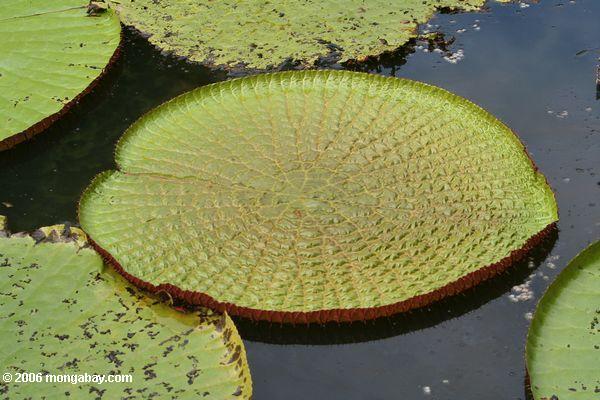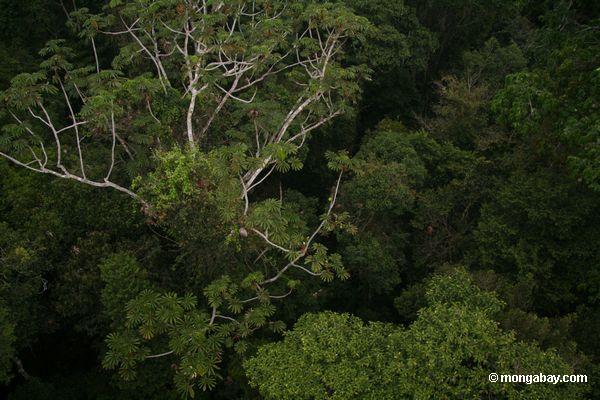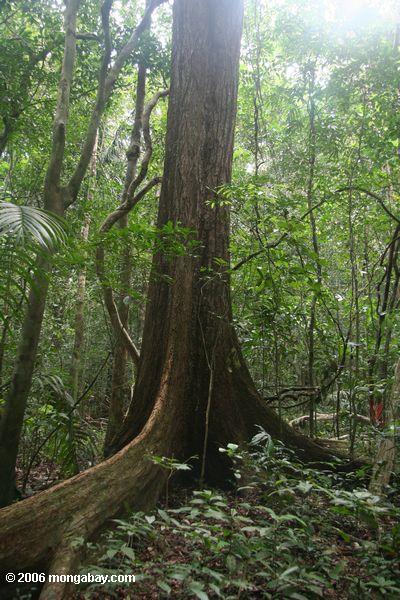Monday, November 16, 2009
Saturday, November 14, 2009
Anaconda
The Amazon Basin, filled with more than one hundred snake species, makes the perfect home to the anaconda snake. It is one of the few snakes that inhabits the water only, although it is capable of moving onto dry land. It preys on whatever comes in its reach, such as rodents, tapirs, capybaras, deer, peccaries, fish, turtles, birds, sheep, aquatic animals, and on the rare occasion people. Anacondas are good swimmers and not usually found in trees. They eat about only once every one or two weeks. They are usually squirmy, but when they are digesting their meal they are sluggish. Small anacondas are one hundred pounds, fifteen feet long, and eight inches wide. Fully grown, on average they are twenty feet long and weigh three hundred fifty pounds. It is rare, but anacondas can reach up to twenty-seven feet long and can weigh up to five hundred pounds. Anacondas kill their prey by first biting it on the neck, taking care not crush it, and then suffocating it to death. This video is of wildlife in the Amazon Region, including the anaconda. Click here to view.

Representaion of Maloca
The maloca represented a person. The ridgepole was the spine and the painted house front was the face. To the Barasana it represented the whole universe. The roof was the sky. The ridgepole was the path of the sun across the heaven. The front door was ‘door of east’ and the back door ‘door of west’. There was an imaginary river under the maloca called the river of the dead. Thenthe sun set west, went upstream through the river, and rose in the east the next morning.

Celebration Dance
After all the work was done the celebration dance begun. It could only be done after the front of the house was painted and it had been attended by all neighboring malocas. It celebrated the end of work and rewarded those who helped. During the dance the shamans chanted and blew spells with smoke from big cigars to make the home strong, protect it form thunder and lightening, and to keep all the inhabitants safe.

Section of Maloca
The malocas had many parts and sections. The men added new sections. One part of the maloca was the garden. The banana trees formed a border between the maloca and the garden. These trees also provided fruit. The gardens were for special plants, like peppers and tobacco, as well as for plants providing medicine and drugs. Some malocas were big gardens called chagras. When sections were to be added to the maloca men collected leaves in the forest. Then they would weave them onto strips of wood. The new sections were put in place from a scaffold inside the house. There were married and unmarried parts of the maloca. Married men made their own screened off compartment in the maloca, where he lived with his wife and children. Unmarried men and guests slept in an open area in the front of the maloca. The maloca included many paths. One path led from the door to the river. Others led from the back door to the gardens, or to a stream. Another led to the forest or neighboring malocas.

Amazon River
The Amazon River was said to have acquired its name from the myth of Francisco de Orellana. It was reported that warriors, similar to the Amazons from the Greek myths, attacked him. Today Brazilians call the Amazon River Amazonas, because of its junction with the Rio Negro. Manaus, the main town in the central area of the Amazon, exists where the Rio Negro joins the Amazon. Another account as to the origin of the Amazon Rivers name might be from the word amassona, which means boat destroyer. The Amazon is 4,000 miles long.It starts in Peru, drops down the Andes, and flows through east Brazil to the Atlantic Ocean. It is the largest in volume and the second longest river in the world. Its width is up to seven miles. It sources in the Andes Mountains. The three main sections of the river are the Rio Negro, White Water, and Manaus. The Rio Negro name comes from its dark and acidic color. It is dark in color because of the Mangrove roots in the river. The people who originally lived by the banks called it the Rio Negro. It is an area free of silt. The white waters are the main course of the river caring away silt and organic matter. It is fed by the Andean tributaries. The natives called it white water. Manaus, where the white and black water meet, runs thirty miles before blending. There are 1,100 tributaries that are interconnected on the Amazon. The Rio Negro is the northern tributary.

Canopy Trees
Plants Living on Trees
Some plants live on trees, such as the Strangler Vine. The tree on which the plant grows is called the host tree. This vine begins to grow on the tree trunk, and then takes nutrients away from the host trees roots by sending its own roots to the ground. The Strangler Vine is named so because it blocks the sunlight from the host tree and causes it to die. Epiphyte, a kind of plant, includes orchids and ferns. They get water, nutrients, and food from the air. Another plant that clings to trees, the lianas, grow with the host tree. These tropical vines in the canopy would otherwise not be able to reach the sunlight. This is a Strangler Vine.

Amazon Water lily
The Amazon water lily, known as the Victoria Regia or Victoria Amazonica grows up to seven feet in diameter. They are the largest water lilies in the world. They blossom only two days a year, with beautiful white flowers. These flowers can grow up to one foot across. Shallow pounds and lagoons are the home to this type of plant. They float and cluster like coasters on the shore. With their huge leaves, they are so strong a person could stand on them.

Canopy
The liveliest part of the forest, where tall tree branches come together to form a green roof is the canopy. The trees here are as tall as one hundred thirty-three feet. The canopy provides shelter for wildlife. The highest layer is the top layer. The trees battered by the wind and pounded by the rain must find ways to survive here. The leaves on the trees are small and waxy which helps them to hold water. Otherwise water is lost to the wind and heat. The emergent layer, which is part of the top layer and the tallest layer, is also known as the winged world, because it is home to many winged animals. Winged animals live here because of the height the emergent layer contains with the crowns, or tops of the tallest trees faning out like umbrellas. Some trees grow as tall as an eighteen-story building.

Understory
Above the forest floor where the understory exists lives small trees. The small trees grow and compete for sunlight. Other trees block the light from the forest floor. The understory is covered with inky darkness. Bright flowers called crab claws fill the understory. Gustavia trees are the home to insects and tarantulas.

Forest Floor
The forest floor is the bottom layer. This warm, damp, and dark layer’s floor is covered in fallen leaves, rotting fruit, and dead animals. The tree roots grow into a thick mat covering the floor. Plants have huge leaves to catch whatever sunlight is available. Earthworms eat the dead plants and animals covering the ground. Fungi, scorpions, millipedes, and bacteria also help decompose dead organisms.

Forest
Part of the environment includes the forest. The Amazon rain forest is five million square kilometers, which equates to two million square miles and covers much of South America. Half of earth’s animal and plant species live in the Amazon forest. The temperature remains about seventy-five to eighty degrees Fahrenheit year round. Some products found in the forest are coca and nuts. Many plants found there can be used as medicine. Many tropical fruits, oils, and spices come from the Amazon area. There are multiple layers of the magnificent forest, including the forest floor, understory, canopy, top layer, and emergent layer. Each layer is home to a different mixture of animals and plants.

Canoe
The river is used for transportation by canoe. River transportation is relatively safe, but travelers must pay attention to water level. Canoes were made from thick tree trunks about twelve feet long. The center was burned until it was wide and deep. The most common form of transportation, the dugout canoe, was heavy and sturdy. The alternative to the dugout canoe was the Yanomami canoe, which was formed from tree bark. People beat the trees with clubs to loosen the bark. After, the bark was removed in a single piece. Next they folded and sealed the ends to make them watertight. To finish, sticks were added to the sides for strength. These canoes were lighter, but less durable than dugout canoes. This is a picture of fished canoes.

Flooding and Low Water on River
The river floods because of rain. There are two rainy seasons, January and July. The rainfall ranges from fifty to one hundred seventy five inches of rain each year. This translates to more than two hundred fifty centimeters of rain each year. The rain on the Amazon basin is different in each area. Some areas receive rain daily, and others receive it rarely but in drenching monsoons. Monsoons occur during the wet winter season, and can dump several inches of rain per hour. In addition to too much water on the river, low water is also dangerous. It increases the probability of striking submerged rocks and tree stumps. The Amazon floodplain is flooded half of the year, and is only moist the other half. Floodwaters recede in late summer. The flooding begins from late November to early December. Over the next few months the floodplain is hit by a deluge of water. This overwhelms the plateaus and meadows. Some floods are extreme while others are minimal. Minimal floods are only one to two feet of water, so water only covers the low ground. During extreme flooding water reaches depths of fifty feet and after the land remains flooded for most of the remainder of the year. This forces animals and people to move to higher ground. It sometimes prevents animals from returning to their homes. This is a picture of the Amazon River.

Monkeys
The Amazon Region is home to many different types of monkeys. On is the Acrobatic monkey, which lives in trees. They feed on leaves and fruits. Another monkey, the Howler monkey, usually lives in troops of about seventeen. It also lives in trees. The Saki monkey has fluffy fur and weighs three to four pounds. Squirrel monkeys have long tails, which help keep them balanced. Spider monkeys swing their prehensile tails as they gather food. The tail has a pad below it like the palm of a hand. The tail is used as a fifth limb. The monkey groups all challenge each other, to make sure other groups stay out of their territory. This is a picture of a Howler monkey.

Thursday, November 12, 2009
Save the Amazon
Watch this video to learn how to save the Amazon!!!!!!!!!!!!!!!!!!!!!! Click here.(in green) Every person can make a difference.
Amazon Rainforest
This is a video about the protecting the Amazon. Click 'video' to view. The Amazon Region is being destroyed more and more every year. Watch this video to learn more ways it is destroyed.
Wednesday, November 11, 2009
Malocas
The Amazonian Indians live in homes, called malocas. The were used for many different reason, including a family home, workspace, and dance house. The homes were built by the men, with help of the neighbors. Maloca commonly had gardens. In the gardens they grew special plants, such as plants that can be used as medicine. In each maloca there was a headman. When the headman died the maloca was left, ant the people living in it all moved together. They would build a new maloca nearby. The oldest brother would lead the building, and become the next headman. The larger the maloca the more prestige the headman had.

Amazon Pink River Dolphin
Amazon Region
The Amazon Region is very unique in its people, environment, and animals. It includes Brazil, Bolivia, Peru, Ecuador, Colombia, Venezuela, Guiana, Suriname, and French Guyana. The climate is very hot and steamy. The Amazon River stretches across South America from the Andes to the Atlantic Ocean. There are many different Indian groups who have lived in the Amazon Region. The Amazon rain forest covers much of South America. The ecosystem is the richest in the world.

Subscribe to:
Posts (Atom)

